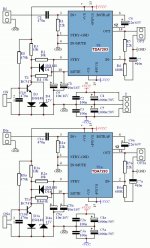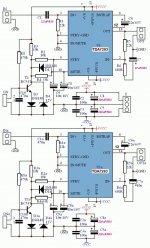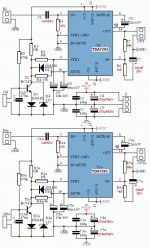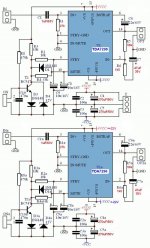4 ohm speakers? High wattage chip amp? That is doable.Hi guys!
Will I create an audio amplifier with TDA7293. I have (dispose) of 250VA transformer with the secondary of 2x27Vac the stereo version. Speakers with impedance of 4R. So please give me a scjematic (circuit) or project Amplifier with TDA 7293 for this power supply.
Thanks for your help!
See also: http://www.diyaudio.com/forums/chip...r-slave-style-no-lossy-emitter-resistors.html
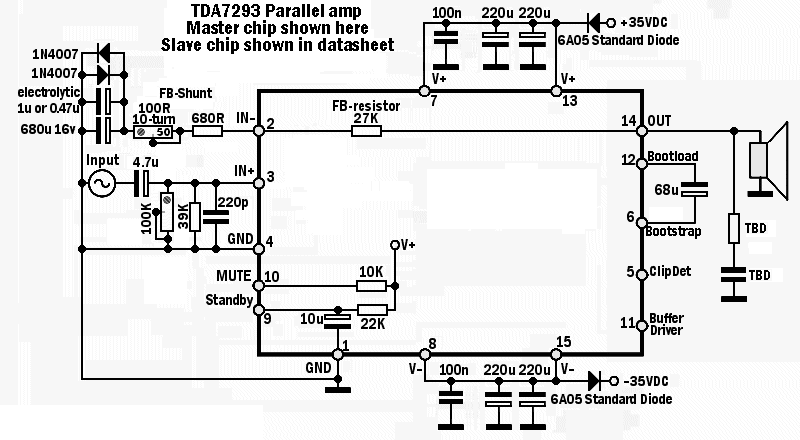
Caution: With 4 ohm speakers it is powerful enough to cause hearing damage from overly loud audio and probably break windows. Don't use it in small rooms--stay well away from the speaker. Other prousound level safety precautions, caveats and liabilities apply.
Daniel, so it should look like this schematic!Yes, it looks like a working amplifier; however, I have some notes:
C1 is slightly too small
C7 is far too small
C4 and C5 are too large
Excessive parts count in mute and standby may cause board layout difficulty
cheers!

Attachments
Last edited:
I'd like to use e.g. tda7293 based amplifier for driving medium powered 4 Ohm (3.2 Ohms Rdc) loudspeakers in such a way that good engineering practices are maintained.
So maximum RMS power in 4 Ohms should be in the 20 to 35 Watts/Ch. range. The power-supply will be able to provide 3 to 4 times the current required for this power.
My questions:
- will the tda7293 still operate correctly at the relative low supply voltage?
- how does the Tda7293 handle extreme current, is the device limited or will it fail?
Thanks in advance
So maximum RMS power in 4 Ohms should be in the 20 to 35 Watts/Ch. range. The power-supply will be able to provide 3 to 4 times the current required for this power.
My questions:
- will the tda7293 still operate correctly at the relative low supply voltage?
- how does the Tda7293 handle extreme current, is the device limited or will it fail?
Thanks in advance
That's a lot better.Daniel, so it should look like this schematic!
cheers!
The input cap, C1 should be, probably 1uF.
The nfb-shunt-cap, C7 does not reach a valid figure when paired with 680R, so simply use 100uF and call it good (even so, that would work better if you at least tripled the 680R and 22K up to 1.8k and 68k, so that the feedback-shunt RC value is a lower pitch for better clearer bass).
The 220uF on C4 and C5 should have the amplifier running nice clear and cool; however, you could use 270uF if you wanted to.
I'd like to use e.g. tda7293 based amplifier for driving medium powered 4 Ohm (3.2 Ohms Rdc) loudspeakers in such a way that good engineering practices are maintained.
So maximum RMS power in 4 Ohms should be in the 20 to 35 Watts/Ch. range. The power-supply will be able to provide 3 to 4 times the current required for this power.
My questions:
- will the tda7293 still operate correctly at the relative low supply voltage?
- how does the Tda7293 handle extreme current, is the device limited or will it fail?
Thanks in advance
For chip amplifiers of this size, generally the protection limiter starts working at 45 watts. The limiter can prevent momentary abuse errors, but it cannot prevent design errors. The power supply should never provide greater current than the amplifier's SOA. Please revise your power supply current estimations into the amplifier's Safe Operating Area. Then it can be a very durable amplifier.
Wattage figure in audio amplifiers is meaningless unless the distortion figure is also mentioned, such as 500 watts at 99.8% distortion or 50 watts at 0.1% distortion could be achieved by one amplifier design, despite the dramatic difference in wattage. Likewise, if you under-volt too far, the distortion figure skyrockets because the amplifier has gone closer to clipping.
Indeed the TDA7293 works delightfully well when under-volted.
It and the TDA7294 are often used for upmarket table radios and other small systems.
Applicable range of transformers include 15+15vac and 18+18vac. I have tested with both. The TDA7293 and TDA7294 both allow and need lower gain when used under-volted, such as 2k7 with 60k or 2k5 with 56k, resulting in a modest gain of 23x. The subjective audiophile performance was better when under-volted although the power output was not.
Yes, that's looking really nice.It came to him like this!
R1 will also adjust the tone with 22k too forwards and 47k too laid back, so perhaps you might like 27k. The difference is minor.
Daniel, thanks for your answer.
I understand that the resistors in the NFB loop ought to be adjusted when the amp is operating under-volted.
The workings of the protection-circuit inside of the chip-amp where not clear to me, so you probably saved me from disaster. So I have to:
a: use more TDA's in parallel
b: restrict the current capabilities of the power-supply.
The latter seems most wise to me.
So a 2x15V 200VA trafo will probably fit the needs...
I understand that the resistors in the NFB loop ought to be adjusted when the amp is operating under-volted.
The workings of the protection-circuit inside of the chip-amp where not clear to me, so you probably saved me from disaster. So I have to:
a: use more TDA's in parallel
b: restrict the current capabilities of the power-supply.
The latter seems most wise to me.
So a 2x15V 200VA trafo will probably fit the needs...
Stereo amplifier with TDA7296
Hi esgigt!
For power suplly 2x15Vac or 2x22Vdc/200VA you fit audio amplifier with TDA7296.
See schematic (circuit)!
cheers!
Daniel, thanks for your answer.
I understand that the resistors in the NFB loop ought to be adjusted when the amp is operating under-volted.
The workings of the protection-circuit inside of the chip-amp where not clear to me, so you probably saved me from disaster. So I have to:
a: use more TDA's in parallel
b: restrict the current capabilities of the power-supply.
The latter seems most wise to me.
So a 2x15V 200VA trafo will probably fit the needs...
Hi esgigt!
For power suplly 2x15Vac or 2x22Vdc/200VA you fit audio amplifier with TDA7296.

See schematic (circuit)!
cheers!

Attachments
Last edited:
Hi Ghost22,Hi esgigt!
For power suplly 2x15Vac or 2x22Vdc/200VA you fit audio amplifier with TDA7296.
See schematic (circuit)!
cheers!
I checked the tda7296 datasheet. But from my point of view the current capabilities of the 7296 will not do. Only 5 Amps where the 7293 does 10A!!
Please take into account that the minimum resistance of the load will be 3.2 Ohms (DC) and that current requirements at full output voltage but with current out of phase, can exceed the 5 Amps of the 7296.
So for load-stability the 7293 fits my requirements better than the 7296.
Anyway, thanks for your response!
Regards, Edwin
Edwin, the 15+15vac transformer with the TDA7293 will get you about 10 watts to 8 ohm speaker or 19 watts to 4 ohm speaker. These wattage figures are also at maximum distortion. If you don't want maximum distortion, add some headroom by using a slightly higher voltage transformer, like 18+18vac. It is still possible to use just 19 watts, but with more headroom, it will have less distortion. See how that goes?
Ever turned the volume knob all the way on a car radio? That's the sound of no headroom, with enough watts but not enough quality. Anyway, the 15+15 is fine if the speakers only use 5W~10W@4R, so then there's headroom and you don't get that BLAAAAHHH!!! noise.
Ever turned the volume knob all the way on a car radio? That's the sound of no headroom, with enough watts but not enough quality. Anyway, the 15+15 is fine if the speakers only use 5W~10W@4R, so then there's headroom and you don't get that BLAAAAHHH!!! noise.
Last edited:
A fair estimate indeed. However, remember the on-chip protection adding distortion at past 45W. An 18+18vac transformer can run the amp very close to 45W@4R. A 20+20vac transformer is also applicable.
However, a 22+22vac transformer with a chip amp and 4 ohm speakers is excessive and probably not a good practice.
However, a 22+22vac transformer with a chip amp and 4 ohm speakers is excessive and probably not a good practice.
Hi,
For the TDA7296 datasheet he writes:
Vs = ±18V; RL = 4Ω:
Po = 5W; f = 1kHz 0.01%
Po = 0.1 to 20W; f = 20Hz to 20kHz <0.1%
Vs = ±22V; RL = 4Ω; Po=60W for d=10%
cheers!
For 22+22VDC rails we can use 15+15VAC transformer multiplied by 1.46 because of the bridge rectifier and caps in the power supply, resulting in 21.9+21.9VDC.
60W@10%THD is not useful because 10% distortion sounds terrible.
That thing is clipping.
BLAAAHHH!!! he says!!
To make it sound nicer, turn down the volume knob.
Therefore, a smaller figure like 15W@0.1%THD is more useful for music.
Reference: ESP SIM (Sound Impairment Monitor)
Cheers!
- Status
- This old topic is closed. If you want to reopen this topic, contact a moderator using the "Report Post" button.
- Home
- Amplifiers
- Chip Amps
- Tda7293v
